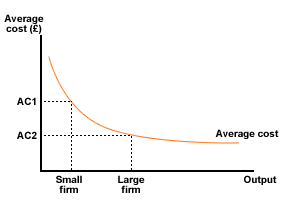Economies and diseconomies of scale AO2 only
AO2 You need to be able to:
Demonstrate application and analysis of knowledge and understanding Command
Terms: These terms require students to use their knowledge and skills to
break down ideas into simpler parts and to see how the parts relate: Analyse,
Apply, Comment, Demonstrate, Distinguish, Explain, Interpret, Sugges
|
Start with a question
Why are there no Hairdressing businesses the same size as Volkswagen cars?Answer - Economies and Diseconomies of scale
|
Definitions
Economies of scale are when the cost per unit of production (Average cost) decreases because the output (sales) increases.
Diseconomies of scale are when the cost per unit of production (Average cost) increases because the output (sales) increases.
Growth brings both advantages and disadvantages to a business. These interact, and depending on the nature of the business and the way it is managed, decide the optimum or most efficient size for the business.
This is the area of economies and diseconomies of scale.
Figure 1 illustrates that average cost falls as output increases, with the result that large firms may enjoy lower costs that smaller competitors. This competitive cost advantage allows large firms to have larger profit margins and have more options in pricing policy.
Figure 1: The effect of economies of scale on average cost
Reasons for economies of scale
The
most common reason for Economies of scale is that some production costs
are fixed (as production increseases these costs stay constant).
Therefore since costs per unit (Average Costs) are calculated by
dividing the cost by the number of units of output
AC=Costs/quantity
Then any average involving Fixed Costs (Numerator) must decrease as quantity produced (Denominator) increases (make sure you follow this ok)
AFC=FC/Quantity
Fixed Cost economies of scale:
1. Managerial - managers are on a fixed salary
2. Marketing - advertising, endorsements promotional events do not directly depend on quantity produced
3. Techinical - machinery, buildings etc are paid for as a fixed amount
Purchasing economies of scale:
Large firms are able to negotiate more favourable terms when buying raw materials etc.
1. Bulk buying - remember it is the cost per unit of buying in bulk not the total cost (Great example is supermarkets and local shop)
2. Financial - similar in principle to buying in bulk but this time interest rates a more favorable.
Reasons for diseconomies of scale
1. Communication - becomes more complex
2. Coordination - between departments
3. X- Inefficiency - management costs increase (non-productive costs)
4. Principle agent problem - delegating to employees who are not as committed as the owner
 1.6 Growth and Evolution AO2, AO3
1.6 Growth and Evolution AO2, AO3